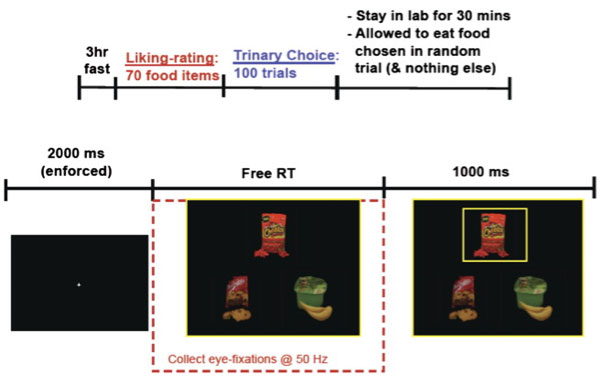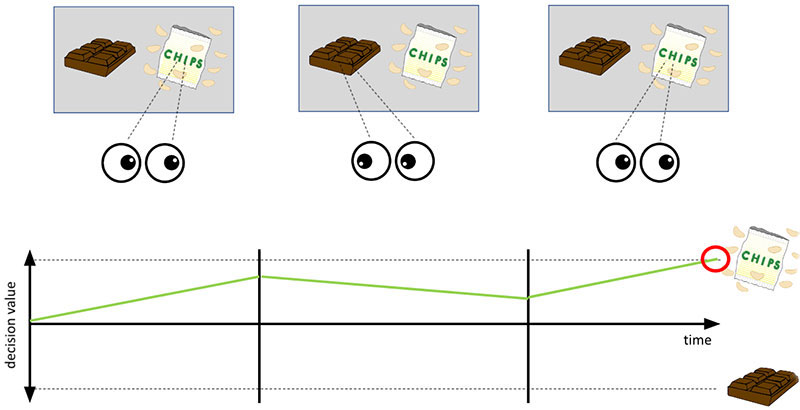| |
Highlights
To understand how we make decisions of preference (what to eat, what to buy, where to live), these researchers developed experiments to monitor eye movements and eye gaze while participants chose between snack foods.
These researchers found that eye gaze (the amount of time spent looking at each item) was an important factor in decision-making, whether deciding between two items or many items. Future avenues of research include experiments where the researchers influence eye gaze and attention, and participants make decisions from memory.
Imagine you want a snack at school and walk over to the vending machine. There are dozens of options for you to choose from. How do you decide which one you want?
Researchers from a variety of backgrounds, including psychologists, economists, and neuroscientists, have been studying how we make decisions in different situations. In settings where we must choose between two options, research over the past decade has shown that people tend to shift attention back and forth between the two options until sufficient interest in one option has been accumulated. This is known as the evidence accumulation model of decision-making. For example, imagine the vending machine at school had only two options. According to this model, you would go back and forth between the two options until you had enough interest in one to choose it over the other.
Dr. Ian Krajbich, Associate Professor of Psychology and Economics and Director of the Decision Sciences Collaborative at Ohio State University, first became interested in the evidence accumulation model of decision-making after seeing the results of a series of experiments in macaque monkeys. In these experiments, researchers
Michael Shadlen and colleagues
recorded the electrical activity of neurons (brain cells) in the macaque brains as they were making decisions about which way clouds of dots were moving on a computer screen.
They showed that electrical activity in the neurons increased over time until it reached a certain threshold. Once activity had reached this threshold, the monkey would make a decision.
Together with his colleagues, Dr. Krajbich developed a series of experiments to see whether a similar process was happening in humans who were expressing their preferences. Rather than recording information directly from the neurons of study participants, Dr. Krajbich and his team measured the amount of time participants spent looking at each option on the screen. This was done using a high-speed camera that recorded the eye movements of participants as they made their decisions.
Sixty-nine students from the California Institute of Technology participated across two studies. Participants were eligible to complete the study if they were not currently on a diet and reported regularly eating snack foods such as potato chips and candy bars. Participants were required to fast for three hours before the study began.
At the start of each study, participants were asked to rate how much they liked each of the 70 items in the study on a scale from -10 to 10. The study items included candy bars such as 3 Musketeers, Snickers, and Twix; chips like Pringles, Doritos, and Cheetos; candy such as Gummy Bears and M&Ms; and crackers, among other snacks. Then, in a series of 100 trials, participants were randomly shown two or three items. Items that the participants said were disliked (rated from -10 to 0 on the scale) were not included. The participants were allowed as much time as they wanted to make a decision in each trial.

Figure 1. Experiment where participants were asked to make a choice between three options (trinary choice). In each trial, participants first looked at a white dot on the screen for 2,000 milliseconds (ms), or two seconds. Participants had unlimited response time (“Free RT”) to make a decision. The chosen item remained on the screen for 1,000 ms (1 second) after being chosen.
[Source:Krajbich and Rangel, 2011.]
The results of these initial studies were in line with the neural recordings from the monkeys. Based on the speed and consistency of their decisions, it appeared as though these human participants were accumulating evidence up to a certain threshold. On top of that, the results showed that the amount of time a participant spent looking at a particular option was a good predictor of which option would be chosen. In other words, the more time a participant spent looking at an item, the more likely they were to choose that item.
Based on these results, the researchers began to think of decisions between two alternatives as a process of gaze-driven evidence accumulation where
gaze amplifies the value
of the item being looked at. Using these findings, they developed computer models that did a good job mimicking the decisions made by human participants.

Figure 2. In the gaze-driven evidence accumulation model of decision-making, eye gaze and attention amplify the value of each item and helps the person make a decision.
[Source: Dr. Ian Krajbich]
Recently, Dr. Krajbich and colleagues Armin Thomas and Felix Molter at the Center for Cognitive Neuroscience in Berlin have extended this work to study how participants make decisions when there are more than a few alternatives, a process known as multi-alternative forced choice.
In this experiment, participants who self-identified as “fans” of snack foods were asked to choose their favorite snack option from different arrays of computer menus. A total of 49 participants fasted for four hours before conducting 200 trials each, 50 trials for each condition of 9, 16, 25, or 36 options.

Figure 3. A) Experiment where participants were asked to make a choice between 9, 16, 25, or 36 snack options. “Free RT” means that response time (RT) was unlimited. B) Later in the study, participants had unlimited response time to rate how much they liked each item, on a scale of -3 (not at all) to 3 (very much).
[Source: Thomas, Molter, and Krajbich, 2021. https://elifesciences.org/articles/57012]
As in previous studies, Dr. Krajbich and his team used a high-speed video camera to track eye movements of the participants during the study. At the end of the study, participants were shown each of the 80 snacks individually and asked to rate them on a seven-point scale, from -3 (don’t like at all) to +3 (like very much). These items were similar to those mentioned above.
After analyzing the data, Dr. Krajbich and his team found the more a participant liked a particular item, as indicated by its rating on the seven-point scale, the more likely the participant was to spend time looking at that item during the trial. In addition, the more items there were to choose from, the less likely it was for a participant to spend time looking at any given item.
Dr. Krajbich and his team also used the data to find patterns in how participants tended to view the items. In general, participants would start by looking in the top left corner, but then where they looked next was not a simple process. As the decision-making process continued, Dr. Krajbich and his team noticed that more highly-rated items and larger items tended to attract more attention. The importance of position on the screen decreased over time. In other words, if an item in the top left corner received initial attention due to its position, it was unlikely to continue to attract attention if it was small or unfavored. The researchers concluded that primarily the liking rating of an item and the number of items in the set contributed to the final decision of which snack to choose.
- https://static-movie-usa.glencoesoftware.com/mp4/10.7554/910/7a6b2e991a8989549867dd8fc7f589ce9e314d5c/elife-57012-video1.mp4
- https://static-movie-usa.glencoesoftware.com/mp4/10.7554/910/7a6b2e991a8989549867dd8fc7f589ce9e314d5c/elife-57012-video2.mp4
- https://static-movie-usa.glencoesoftware.com/mp4/10.7554/910/7a6b2e991a8989549867dd8fc7f589ce9e314d5c/elife-57012-video3.mp4
- https://static-movie-usa.glencoesoftware.com/mp4/10.7554/910/7a6b2e991a8989549867dd8fc7f589ce9e314d5c/elife-57012-video4.mp4
Figure 4. Animation of eye gaze during experiments with A) 9, B) 16, C) 25, and D) 36 options.
[Source: Thomas, Molter, and Krajbich, 2021.https://elifesciences.org/articles/57012]
The researchers found that study participants differed in which item attributes were most important to them. For example, participants who were most influenced by how much they liked an item tended to look at fewer items overall and spend more time looking only at the items they liked. They were more likely to choose the item they liked the most and also more likely to choose the last item they looked at. Participants who were more influenced by the size of each item also tended to look at fewer items, but they were less likely to choose the last item they looked at.
Dr. Krajbich and his team noticed differences between participants who made their decisions more quickly and those who made decisions more slowly. Since participants generally began by looking at items positioned on the left side, those who made quicker decisions tended to be more influenced by item position and spend more time looking at items on the left side. Participants who made slower decisions tended to take a more balanced approach to looking at items both on the left and the right side.
Based on the results of this study with many alternatives, Dr. Krajbich and his team concluded that eye gaze and attention are important indicators in the evidence accumulation process behind decision-making, whether there are two options or 36 options. With this in mind, Dr. Krajbich and other researchers are investigating
ways to influence eye gaze and attention,
such as changing the size and position of different items or making them more or less eye-catching.
Another avenue for future research is to study the decision-making process when the possible options are not right in front of you. For example, if you were asked to choose a snack from the school vending machine while you were at home, how would you make that decision? How would it be different from the decision you would make if you were at school in front of the vending machine? These are the types of questions that Dr. Krajbich hopes to answer in ongoing research on decision-making processes.
Dr. Ian Krajbich is Association Professor of Psychology and Economics and Director of the Decision Sciences Collaborative at Ohio State University. His current research focuses on how we make decisions of preference: what to eat, what to buy, where to live, etc., and the role of eye gaze and attention in these decision-making processes. When not in the laboratory, Dr. Krajbich enjoys hiking, biking, playing and watching baseball, listening to music—especially hard rock and metal, and watching horror movies.
For More Information:
- Thomas, R., F. Molter, and I. Krajbich. 2021. “Uncovering the computational mechanisms underlying many-alternative choice.” eLife.https://elifesciences.org/articles/57012
- Smith, S. M., & I. Krajbich. 2019. “Gaze amplifies value in decision making.” Psychological Science, 30(1): 116-128. https://pubmed.ncbi.nlm.nih.gov/30526339/
- Gwinn, R., Leber, A. B., & Krajbich, I. The spillover effects of attentional learning on value-based choice. Cognition 2019; 182: 294-306. https://pubmed.ncbi.nlm.nih.gov/30391643/
- Krajbich, I. and A. Rangel. 2011. “Multialternative drift-diffusion model predicts the relationship between visual fixations and choice in value-based decisions.” Proceedings of the National Academy of Sciences, 33: 13852-13857. https://www.pnas.org/content/108/33/13852
- Gold, J. I., and M. N. Shadlen. 2007. “The neural basis of decision making,” Annual Review of Neuroscience, 30: 535-574. https://www.annualreviews.org/doi/10.1146/annurev.neuro.29.051605.113038
To Learn More:
- Ian Krajbich Neuroeconomics and Decision Neuroscience Lab. https://u.osu.edu/krajbichlab/
- How people decide when they have so many choices.https://news.osu.edu/how-people-decide-when-they-have-so-many-choices/
- Society for Neuroeconomics. https://neuroeconomics.org/
- Decision-making. https://www.psychologytoday.com/us/basics/decision-making
Influencing Eye Gaze and Attention
- Towal, R. B., Mormann, M., & Koch, C. Simultaneous modeling of visual saliency and value computation improves predictions of economic choice. Proceedings of the National Academy of Sciences 2013;110(40); E3858-E3867. https://pubmed.ncbi.nlm.nih.gov/24019496/
- Pärnamets, P., Johansson, P., Hall, L., Balkenius, C., Spivey, M. J., & Richardson, D. C. Biasing moral decisions by exploiting the dynamics of eye gaze. Proceedings of the National Academy of Sciences 2015; 112(13): 4170-4175.https://pubmed.ncbi.nlm.nih.gov/25775604/
Written by Rebecca Kranz with Andrea Gwosdow, PhD at www.gwosdow.com
HOME | ABOUT | ARCHIVES | TEACHERS | LINKS | CONTACT
All content on this site is © Massachusetts
Society for Medical Research or others. Please read our copyright
statement — it is important. |
|
|

Dr. Ian Krajbich

Dr. Armin Thomas

Dr. Felix Molter
Sign Up for our Monthly Announcement!
...or  subscribe to all of our stories! subscribe to all of our stories!

What A Year! is a project of the Massachusetts
Society for Medical Research.
|
|

